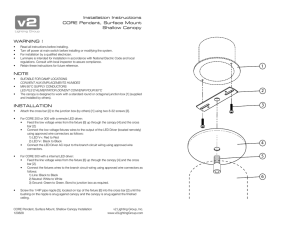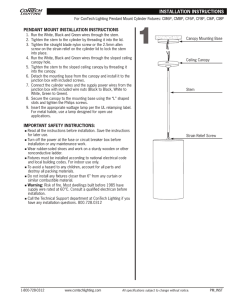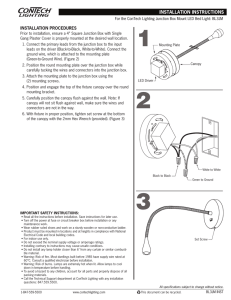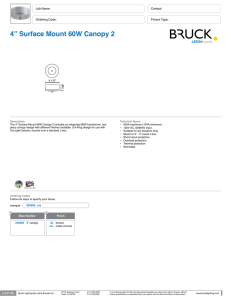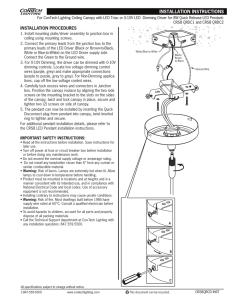canopy installation
advertisement
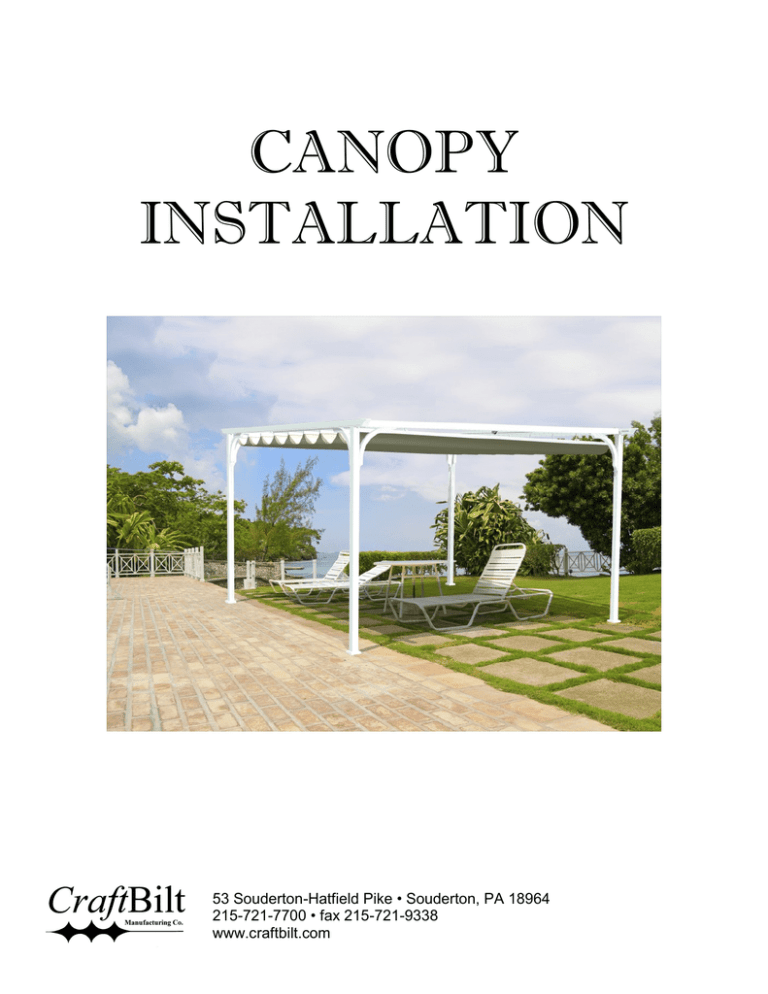
CANOPY INSTALLATION 53 Souderton-Hatfield Pike • Souderton, PA 18964 215-721-7700 • fax 215-721-9338 www.craftbilt.com TABLE OF CONTENTS Canopy Installation A. Tool List…………………………………………………………………………………… Page 3 B. Introduction……………………………………………………………………………….. Page 4 C. Unpacking………………………………………………………………………………… Page 4 D. Preparing to Install…………………………………………………………..…………... Page 4 E. Site Planning and Key Points……………………………..……………………………. Page 5 F. Free Standing Canopy Installation…………………….…...………………………….. Page 6 G. Fabric Assembly and Installation………………………………….……….………….. Page 9 H. Rope Installation…………………………………………………..…………………….. Page 11 I. Wall Mount Canopy……………………………………………………………………... Page 14 J. Under mount Continuous Fabric/Joined Canopy………………………..…………... Page 18 K. Multiple Joined Canopy……………………………………….………………………… Page 20 L. Canopy Post and Gusset Assembly…………………………………………………. Page 22 M. Canopy Parts List………………………………………………………………………... Page 23 N. Optional Side Curtain Installation……………………………………………………… Page 24 All information contained herein subject to errors and omissions. 2 TOOL LIST Tools listed below are required to install and service all models of Craft-Bilt Manufacturing Canopies. Not every tool is required for every installation. 3/8" reversible drill Hammer drill for concrete installations 3/8” masonry drill bit 1/4” & 3/8” high speed drill bits 1/4” hex driver, Square drive bit for side curtains 1/2” impact wrench 1/2” drive sockets 7/16”, 9/16” and 3/4” 1/2” drive ratchet 13 and 17mm mm combination wrench 3/8 drive ratchet with 13mm and 17mm Sockets and 4” extension. Philips head screw driver Allen wrenches, metric: 3mm, 6mm Utility knife Tape measure 4’ Level Chalk line Soapstick or piece of chalk Touch up paint Eye protection Proper ladders Flat pry bar 10-12” chop saw (only required if trimming extrusions) Additional Hardware and Materials The following hardware or materials may be required, depending on your installation: • 2” x 8” kiln dried lumber for mounting board on house wall applications • 5/16” x 4” galvanized lag screws, for installing mounting board to studs in house wall (available from Craft-Bilt in bags containing 25 lags and 25 washers - # 73COFS08XXXX) • 1/4” galvanized washers • 1/2” galvanized washers (for shimming) • Trim nails • Vinyl capping or aluminum coil to cover mounting board (Vinyl capping is available from Craft-Bilt) 3 INTRODUCTION Thank you for choosing a Craft-Bilt Manufacturing retractable canopy. For this canopy to operate as designed, it must be properly installed. Please follow these instructions exactly and use all the components and fasteners, as described. Retractable canopies are intended as protection against sun only. Do not use in strong wind, rain, hail or snow. Every home improvement project should begin with safety precautions. Always wear eye protection and follow the safety instructions that came with your tools. A typical installation requires at least two or three people, depending upon the weight of the awning and accessibility at the site. Be careful of staples when opening the shipping carton. UNPACKING The canopy extrusions are wrapped with bubble wrap. Carefully lift out the extrusions, and remove from the box and lay on a flat, level surface. Be careful not to cut the awning fabric when removing wrapping. Clean hands of grease/dirt before handling the fabric. Check the canopy against the packing list. Notify the Craft-Bilt Customer Satisfaction Department at (215) 721-7700 if you feel there are any discrepancies. The canopy is shipped partially assembled. Please follow installation instructions for your canopy type and mounting situation. All the canopies must be securely fastened to a wooden deck or concrete pad. There are two canopy types, one is designed to be wall mounted, the other is free standing. PREPARING TO INSTALL Relocate hanging objects from inside wall during installation. Wall installations use two or more mounting brackets supplied with the canopy. It is critical that all brackets are mounted level, plumb and on the same surface plane. Misaligned brackets will affect the appearance and functioning of the canopy. Refer to the appropriate section for your installation. NOTE: There is no approved method for mounting the canopy to a fascia. Only professional installers should attempt to install awnings on structures with stone, cedar shake, or EIFS (exterior insulated finish system) exteriors. Pressure treated lumber CANNOT be used. All pressure treated lumber is corrosive to fasteners, aluminum and anchors which would cause serious harm if failure occurs. 4 Site Planning and Highlights to a Trouble Free Installation. 1. Double check measurements of pad/deck with the measurements of the canopy. 2. Check for slope in pad/deck. 3. Depending on the amount of measured slope canopy posts may be cut down. If the slope exceeds more than 2” custom posts are available. 4. All canopies must be installed plumb and level (The slope is built into the fabric trolleys.) 5. For side curtains to operate properly posts must be plumb +-1/8” from top to bottom. 6. If installing a side curtain, it is highly recommend not to have the crank operator and rope pull in the same corner. 7. Make sure to install the longer trolleys in the direction you want the water to run. 8. Do not fasten feet to pad/deck until the canopy frame work is completely assembled. 9. The rope cleat can be located in any of the 4 corners. However it’s recommended location is on one of the posts below where the fabric gathers. 10. It is recommended that you layout all the posts and beams on the ground first. (Much of the canopy is factory assembled and therefore you have lefts/rights etc.) 11. It is recommended to assemble one side at a time by laying the parts on the ground (must be flat.) Then stand each side up and connect them with the beams. 12. Build the entire frame work (including the gussets) before installing the fabric. 13. A parts list with part numbers is included with these instructions for reference and for replacement parts. 5 Basic Free Standing Installation These instructions cover the generic aspects of a canopy installation. After thoroughly reviewing all installation materials please contact Craft-Bilt Manufacturing Co. customer satisfaction department with any remaining questions. If you are installing a wall mount version please see instructions on page 14. 1. Layout all posts, beams, and trolley channels on the ground. 2. There are lefts and rights for the pre-assembled posts so make sure they are laid out correctly. (T -slots must face to the inside and the connecting plates run parallel with the beams that over hang. (See figure A below) 3. Determine the slope or pitch of the pad. Trim the posts to match the slope. Slope greater than 2” requires a special order post size. 4. Layout the first 2 posts, gussets and beam on the ground. Using the trolley channel to set the spacing is also recommended. (See fig. A below) 5. Slide (2) 20mm x 20mm threaded nuts into each end of the beam. 6. Locate the outer edge of each post 6.5” from the end of the beam. 7. Use (2)M8 x 18mm hex bolts along with (2) 8mm flat washers to fasten connecting plate to beam. 8. Check that the posts are plumb with the beam. 9. Using a 6mm hex (Allen) wrench insert rhombus nuts from gussets into T-slots on beam and post, make sure that rhombus nut is seated properly, then tighten up bolts. If any part of the rhombus nut can be seen after installation, it is not properly seated. Rhombus nut orientation Figure A 6 Basic Installation Continued 10. Stand up both assemblies and temporarily brace as necessary. 11. Install M8 X 18mm hex head bolts and 8mm washers into the connecting plate holes. Hold bolts in place with 20mm square threaded nut. Repeat for other crossbeam. 12. With both assemblies standing lift up crossbeams and insert the 20mm square threaded nuts into the T-slots on the upper beams. Align with posts. (See detail A) Hand tighten bolts just enough to hold crossbeams in place. (See figure B) 13. Repeat for other side. 14. The finished frame should look like Figure E on page 8. Adjust beam locations to match posts if necessary. Figure B 14. Layout the Trolley Channel extrusions. Look for the end that contains the notch out and 4 holes (See figure C.). This is the fixed side for the fabric, it is the side that the fabric gathers to. 15. The Trolley Channel measurement from the end of the beams must be determined. The factory has set this dimension based on the length of the Fabric Crossbars. Figure C See figure D on how to measure and place a mark on the crossbeam. Note: If your canopy is motorized, please refer to the motorized supplement instructions. The exact Trolley Channel distance will be dictated by the length of the drive tube. Figure D 7 Basic Installation Continued 16. Locate the factory installed M8 threaded nuts in the Crossbeam and slide them approximately 4” from both sides of your marks in step 15. 17. Align each end of the Trolley Channel with your mark (step 15) and secure with (2) M8 x 18mm bolts and (2) M8 flat washers. 18. Inspect the alignment of both Crossbeams to the posts. Make sure the t-slots are aligned. 18. Tighten all M8 bolts. Figure E 19. Install the remaining 4 Gussets on each of the 4 corners. 20. Once the frame is completed and all the fasteners are tightened, you may move the canopy into it’s final position. Before fastening, adjust each post for plumb. Then fasten the feet down with the appropriate anchor and quantity (3/8 x 3” lags for wood, 3/8 x 3” anchors for masonry). 8 Basic Installation Continued—Fabric Assembly and Installation Depending on the canopy width and projection the fabric may not be shipped completely assembled. You will have either single fabric or double fabric. Single fabric utilizes a rope. Here we will explain how to assemble the fabric. Please take your time to avoid tearing the fabric. 1. Place the canopy crossbars and their associated fabric on a clean flat working surface. on i t c 2. Depending on the size of the ire ed d e f c ri canopy the Fabric Crossbar End Fab Caps be pre-installed. Remove by unscrewing the #8 SS sheet metal screw from the end. Make sure to save it so it can be re-installed later. Seam opening 3. The chance of tearing the fabric is reduced if you slide the fabric in the direcHems tion with the seams. 4. Make sure the fabric hems are on the top. 5. The fabric should be 1/4-1/2” from the end of the bars. Trim spline if necessary. 6. To maintain the fabric flutes either a 1/8” rope is used through the Fabric Crossbar Trolley Mounts or a secondary piece of material is used. 7. Depending on the size of the canopy, the secondary fabric may be either inserted on the ground, or for larger units often after the fabric is installed on the Canopy. Be sure to place the fabric hems down. Install the Fabric Crossbar end caps. UPPER FABRIC 8. If using the rope, install the fabric on the canopy. Then install the rope by threading it through the Trolley Mounts. Look for the black marks on the rope placed by the factory. They are the locations that you tighten the M4 screw against. Do not over tighten or you will strip the threads. Rope 9 Basic Installation Continued—Fabric Installation & Final Assembly 21. Determine which direction you want the fabric to slope/pitch. There are up to 3 lengths of Trolley Assemblies. Install the longest of the trolley assemblies in the direction of the slope/pitch 22. Complete the Trolley Assemblies by removing the Hair Cotter Pin and Clevis Pin from the Trolley Mount and install the lower portion of the rod, then re-install the pins. Do this for all the Trolley Assemblies. The last trolley is the fixed one Fixed Trolley 23. With the end opposite of the fixed trolley, (see figure F for fixed trolley) work in unison, and begin feeding the trolley assemblies into the notch in the Trolley Channel, pushing them down the channel as you go along. 24. After the last wheeled trolley is inserted, the last one is the fixed one. 25. Remove the fixed rod by removing the hair cotter pin and clevis pin. (Figure F) Figure F 26. Carefully let the fabric and rails hang down. 27. Insert the fixed end into the notch by sliding it forward then back over the mounting holes. Make sure the orientation is correct. (Figure G) 28. Fasten each fixed trolley with (4) #8 x 3/4 hex head tek screws. 29. Attach Fabric Crossbar to fixed trolleys with the clevis and hair cotter pin. 29. Install the foot covers over each post. They are two pieces, twist them apart, then slide them down the post and twist them back together. 30. Install the Post and Beam End Caps. Use (2) #10 x 1” pan head screws on the bottom of each one. 31. Install the plastic M8 Bolt Covers over all the M8 hex head bolts. Figure G 10 will become tangled by the crank handle hook.) If you are mounting a gear operated side curtain DO NOT attach the rope cleat to the same corner as the gear. (The rope Correct installation of the pull rope is critical to smooth operation. Basic Installation Continued—Preferred Rope Installation 11 Basic Installation Continued—Alternate Rope Installation 12 Free Standing Canopy Part Locations 13 Wall Mount Canopy—Supplement The construction of the wall mount version of the Canopy is very similar to the free standing version. 1. It is very important that you have a flat surface to mount the canopy. 2. A 2 x 8 kiln dried hem fir mounting board is recommended for siding applications. Be sure to cut out the siding, lag the board to the wall, and flash the board appropriately. Cover the board with trim coil or CBM vinyl cover. (Step by step instructions are available.) 3. Determine the mounting height of the board. If the pad is level then the top of the side beams is 102 5/8” (see page17). If your pad is sloped you will have to adjust that height accordingly. Snap a chalk line for the mounting height to insure the beams are mounted level with each other. 4. The Pivot Brackets are mounted to the board with 5/16 x 2” lag bolts, supplied by others. 5. Fabric must be sloped away from the house to prevent water running down the foundation. 6. It is recommended that the rope cleat be mounted to one of the canopy posts. 7. Layout Post & Beam and Trolley Channels extrusions on a flat surface. Assemble them as shown below. 8. Tighten all M8 bolts 9. Attach Pivot Bracket Post and Beam. Refer to Drawing below for more details on Pivot Bracket assembly. 10. Please refer to the attached drawings on pages 15-17 for additional information. 14 Wall Mount Canopy-Continued Pivot Bracket Assembly Detail 15 Wall Mount Canopy-Continued 11. Using two people, lift up the frame and place it into the Pivot Brackets. Fasten Brackets together with the M10 bolt, washers and lock nut. See page 15 for fastener details. 12. Using two people lift up the free side of the frame and place the legs under it. Fasten them securely. 13. Follow the remaining steps for a Free Standing Canopy to finish the installation. 16 Flush Wall Mount Canopy Part Locations 17 Under Mount Continuous Fabric/Joined— Supplement Continuous fabric configured canopies require the trolley channels mounted under the beams. 1. Follow all the steps for building the frame work for a standard free standing unit. 2. Review the attached drawings on page 17 to determine how the 3 way posts/beams are used, and where the additional gussets are attached.. 3. Trolley channels must always be joined below a crossbeam. Beams must always be joined over a post. A third Trolley channel is used on projection greater than 14’. An additional beam is placed above the gathered fabric on projections greater than 16’. 4. The Trolley Channels are mounted with Trolley Channel Under Mount Brackets and are joined with Trolley Channel Joiner Brackets. We recommend you first hand tighten the brackets to the beams. Then install the remaining bolts and square nuts into the brackets. Working from one end, lift up the Trolley Channel and slide the t-slots in the Trolley Channel onto the square nuts on the Trolley Channel Under Mount Brackets, then pull back to the Joining Bracket. The holes on the Under Mount Brackets are offset to help. 5. Only one set of trolley channels have a notch for the Fixed Trolley Assembly. 6. Post and Beam End Caps are used to close off the end of each trolley channel. 7. See the drawing below for the pulley locations. Only two universal pulleys are used on opposing beams. 18 Free Standing Joined (Continuous Fabric) Canopy Part Locations 19 Free Standing Multiple Joined Canopy—Supplement Assembling a multiple joined canopy is basically single units jointed together using common posts. 1. Review the attached drawings for the use of 3 and 4 way posts/beams, and additional gussets are attached. 2. Follow all the steps for building the frame work for a standard free standing unit. 3. All Trolley Channels are flush to the cross beams. 4. Orient Trolley Channel notched ends so that the fabric is always gathered on opposite ends. The fabric must never be joined towards each other. 5. Refer to the Joined Canopy part location drawing on page 19 for additional information. 6. An optional Rain Cover is available. It snaps into the center 3 way beams as seen below. It is used in between canopy sections to cover the gap between the sections. It is sold in lineals and cut on the job site to fit. See below for how to snap it in place. START IN TOP AND SNAP DOWN 75EXRCO118 SNAP IN RAIN COVER 20 Free Standing Multiple Joined Canopy Part Locations 21 Canopy Post and Gusset Assemblies 22 Canopy Hardware and Parts 23 Optional Side Curtain Installation 1. Determine which side the curtain is to be installed. 2. Check the canopy posts for square and plumb. The side curtain tracks must be installed square and plumb. The maximum tolerance is approximately 3/16 overall. If greater, you must either adjust the posts or install the side curtain rails out of plumb relative to the posts. 3. Measure 1 1/4” down from the beam and place mark. This will be the mounting location for the side curtain mounting bracket. See figure H 4. Determine which side is the gear operator or motor mounted side, and the idle side. 5. Align the rhombus nuts and mount the idle side curtain mounting bracket on the canopy post. Tighten both M8 bolts. Caution: The Figure H rhombus nuts must be installed correctly or the curtain could fall! 6. Lift up fabric roll and insert idle gudgeon into bushing, align gear/motor mounting bracket and rhombus nuts, place at your mark and tighten both M8 bolts. (Note: the fabric roll feed from the inside of the canopy.) 7. Gather the 2 guide tracks. There are a left and right, look for the end caps, they are at the bottom and set on the canopy foot covers. 8. Place the drop bar end guides into the tracks and plumb the tracks and clamp to hold in position. 9. Drive the #8 x 1.00” sq. drive. screws into the clearance holes provided in the rails. 10. Repeat for the other side. 11. Snap plastic hole covers into pre-drilled clearance holes. 12. Operate shade up and down to check for proper operation. Adjust as necessary. 13. Refer to page 23 for additional information. 24 Optional Side Curtain Part Locations 25 26
